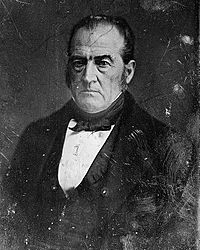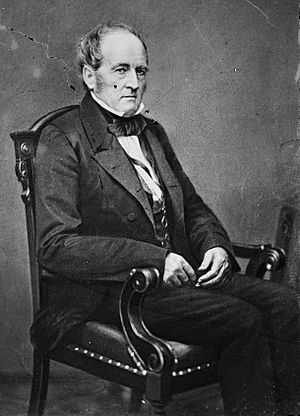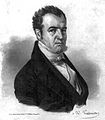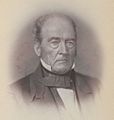John Bell (Tennessee politician) facts for kids
Quick facts for kids
John Bell
|
|
|---|---|
 |
|
| 16th Speaker of the United States House of Representatives | |
| In office June 2, 1834 – March 4, 1835 |
|
| President | Andrew Jackson |
| Preceded by | Andrew Stevenson |
| Succeeded by | James K. Polk |
| Member of the U.S. House of Representatives from Tennessee's 7th district |
|
| In office March 4, 1827 – March 3, 1841 |
|
| Preceded by | Sam Houston |
| Succeeded by | Robert L. Caruthers |
| 16th United States Secretary of War | |
| In office March 5, 1841 – September 13, 1841 |
|
| President | William Henry Harrison John Tyler |
| Preceded by | Joel R. Poinsett |
| Succeeded by | John C. Spencer |
| United States Senator from Tennessee |
|
| In office November 22, 1847 – March 3, 1859 |
|
| Preceded by | Spencer Jarnagin |
| Succeeded by | Alfred O. P. Nicholson |
| Personal details | |
| Born | February 15, 1797 Nashville, Tennessee |
| Died | September 10, 1869 (aged 72) Dickson County, Tennessee |
| Political party | Democratic-Republican Democratic National Republican Whig American Constitutional Union |
| Spouses | Sally Dickinson Bell Jane Yeatman Bell |
| Alma mater | Cumberland College |
| Profession | Law |
John Bell (February 15, 1797 – September 10, 1869) was an important U.S. politician, lawyer, and plantation owner. He was from Tennessee and served in the United States Congress. He was a member of both the House of Representatives and the Senate.
Bell started his political journey as a Democrat. However, he later disagreed with President Andrew Jackson. Because of these disagreements, he joined the Whig party. In 1860, he ran for President but lost to Abraham Lincoln. This election was very divided and helped lead to the American Civil War.
Contents
Early Life and Political Start
John Bell was born in a small town called Mill Creek, near Nashville, Tennessee. His father, Samuel Bell, was a blacksmith and farmer. John went to Cumberland University and finished his studies in 1814. After college, he studied law and became a lawyer in 1816. He built a successful law practice in Franklin.
Bell started his political career in 1817. He was elected to the Tennessee State Senate. After serving one term, he decided not to run again and moved to Nashville.
Serving in the U.S. House
In 1826, Bell was elected to the Twentieth United States Congress. He represented Tennessee's 9th Congressional District in the U.S. House of Representatives from 1827 to 1841.
At first, Bell strongly supported President Andrew Jackson. But they disagreed over the Bank of the United States. This was a big debate about how the country's money system should work. Because of this disagreement, Bell left the Jacksonian Democrats.
Bell served as the Speaker of the House from 1834 to 1835. The Speaker is the leader of the House of Representatives. He tried to become Speaker other times but was defeated by his rival, James K. Polk. Polk was also a Congressman from Tennessee. Bell also led the Committee on Indian Affairs and worked on the Committee on Judiciary.
Secretary of War and Senator
After his time in the House, Bell briefly served as Secretary of War in 1841. He worked for Presidents William Henry Harrison and John Tyler. However, he resigned from this job along with other cabinet members. They were protesting President Tyler's decisions to reject some laws the Whig Party wanted.
Bell then went back to Tennessee. He invested his money in railroads and factories. He also continued to oppose James K. Polk in politics. Polk won the presidency in 1844, but Bell's efforts helped prevent Polk from winning Tennessee.
In 1847, Bell returned to politics in Tennessee. He was elected to the State House of Representatives. His party, the Whigs, then chose him to serve in the United States Senate. He was a Senator until 1859. Bell supported the Compromise of 1850, which was a series of laws about slavery. He was one of only two Southern senators to vote against the Kansas–Nebraska Act. This act allowed new territories to decide if they would allow slavery.
John Bell was married twice. First, he married Sally Dickinson. After she passed away, he married Jane Yeatman.
Running for President
In the 1850s, the Whig Party started to fall apart. John Bell became a leader for a small group of politicians. They were mostly Whigs from states that bordered the North and South. They tried to keep the Whig Party alive in a new way.
This group formed the Constitutional Union Party. Bell became their candidate for President in 1860. Many people saw this party as a last effort to save the Whig Party. It was a moderate party, meaning it tried to find a middle ground.
The 1860 Presidential election was very complicated. There were four main candidates. Abraham Lincoln of the Republican Party won the election. Bell received 39 electoral votes and about 592,906 popular votes. Lincoln was not even on the ballot in some Southern states.
Bell won the states of Virginia, Kentucky, and Tennessee. This happened partly because the Democratic votes were split between two other candidates: John C. Breckinridge (who represented the South) and Stephen A. Douglas (who represented the North). Bell received very few votes in the Northern states.
Later Life
At first, John Bell was against states leaving the Union (called secession). He even went to Washington D.C. to meet with President Lincoln. Bell was successful in helping Tennessee stay in the Union for a while.
However, after the attack on Fort Sumter in South Carolina, President Lincoln asked states to send troops. After this, Tennessee decided to secede. Bell was very sad about this and retired from politics. He was also not in good health.
He joined a group of business people who invested in saltworks and ironworks. These were factories that made salt and iron. He bought a share in the Cumberland Furnace near Charlotte, Tennessee. Sadly, most of his businesses were badly damaged or destroyed during the Civil War.
John Bell passed away in 1869 at his home. It was located near the Cumberland River, close to the Cumberland Furnace and Dover, Tennessee. He was buried in Nashville's Mt. Olivet Cemetery.
His son-in-law, Edwin Augustus Keeble, was a Congressman for the Confederate States.
Images for kids
-
A photograph of Bell taken by Julian Vannerson.
-
A photograph of Bell by Mathew Brady.
See also
 In Spanish: John C. Bell para niños
In Spanish: John C. Bell para niños








